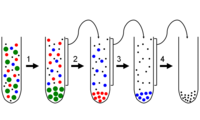Differential centrifugation

Ok, imagine that you have a very messy room. There are toys, clothes, books, and other things scattered all over the place. You want to clean up your room and make it nice and organized.
But some of the things in your room are different from each other - some are big, some are small, some are heavy, some are light. You need a way to separate them based on their differences, so you can clean each group separately and put them back in their proper place.
This is kind of like what scientists do when they want to study the different parts of cells. Cells are like tiny factories that do all kinds of jobs in our bodies, and they have different structures and functions that can be hard to see if we just look at them under a microscope.
So scientists use a method called "differential centrifugation" to separate the different parts of cells. This involves putting the cells in a special machine called a centrifuge, which spins them around very fast.
As the cells spin, the heavier parts get flung to the bottom of the centrifuge tube, while the lighter parts stay on top. Scientists can then carefully remove each layer from the tube, like peeling an onion, and study the different parts separately.
For example, they might be interested in the mitochondria, which are like mini power plants inside cells that produce energy. By using differential centrifugation, they can isolate the mitochondria and study how they work.
Overall, differential centrifugation is a way for scientists to separate and study the different parts of cells, kind of like how you might clean your messy room by separating your toys, clothes, and books based on their size and weight.
But some of the things in your room are different from each other - some are big, some are small, some are heavy, some are light. You need a way to separate them based on their differences, so you can clean each group separately and put them back in their proper place.
This is kind of like what scientists do when they want to study the different parts of cells. Cells are like tiny factories that do all kinds of jobs in our bodies, and they have different structures and functions that can be hard to see if we just look at them under a microscope.
So scientists use a method called "differential centrifugation" to separate the different parts of cells. This involves putting the cells in a special machine called a centrifuge, which spins them around very fast.
As the cells spin, the heavier parts get flung to the bottom of the centrifuge tube, while the lighter parts stay on top. Scientists can then carefully remove each layer from the tube, like peeling an onion, and study the different parts separately.
For example, they might be interested in the mitochondria, which are like mini power plants inside cells that produce energy. By using differential centrifugation, they can isolate the mitochondria and study how they work.
Overall, differential centrifugation is a way for scientists to separate and study the different parts of cells, kind of like how you might clean your messy room by separating your toys, clothes, and books based on their size and weight.
Related topics others have asked about:
